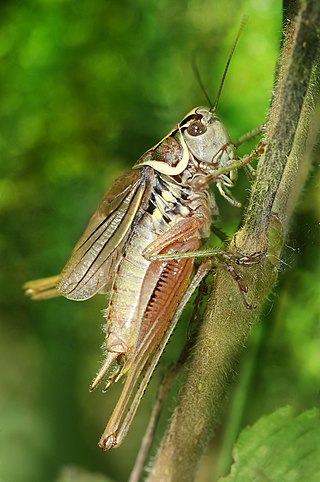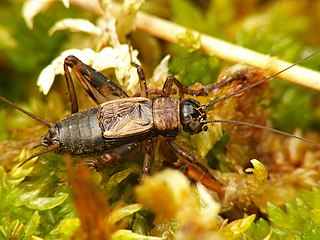
Insects in the family Tettigoniidae are commonly called katydids or bush crickets. They have previously been known as "long-horned grasshoppers". More than 8,000 species are known. Part of the suborder Ensifera, the Tettigoniidae are the only extant (living) family in the superfamily Tettigonioidea.

Orthoptera is an order of insects that comprises the grasshoppers, locusts, and crickets, including closely related insects, such as the bush crickets or katydids and wētā. The order is subdivided into two suborders: Caelifera – grasshoppers, locusts, and close relatives; and Ensifera – crickets and close relatives.

The Phasmatodea are an order of insects whose members are variously known as stick insects, stick-bugs, walkingsticks, stick animals, or bug sticks. They are also occasionally referred to as Devil's darning needles, although this name is shared by both dragonflies and crane flies. They can be generally referred to as phasmatodeans, phasmids, or ghost insects, with phasmids in the family Phylliidae called leaf insects, leaf-bugs, walking leaves, or bug leaves. The group's name is derived from the Ancient Greek φάσμα phasma, meaning an apparition or phantom, referring to their resemblance to vegetation while in fact being animals. Their natural camouflage makes them difficult for predators to detect; still, many species have one of several secondary lines of defense in the form of startle displays, spines or toxic secretions. Stick insects from the genera Phryganistria, Ctenomorpha, and Phobaeticus include the world's longest insects.

Mole crickets are members of the insect family Gryllotalpidae, in the order Orthoptera. Mole crickets are cylindrical-bodied, fossorial insects about 3–5 cm (1.2–2.0 in) long as adults, with small eyes and shovel-like fore limbs highly developed for burrowing. They are present in many parts of the world and where they have arrived in new regions, may become agricultural pests.

Grasshoppers are a group of insects belonging to the suborder Caelifera. They are among what is possibly the most ancient living group of chewing herbivorous insects, dating back to the early Triassic around 250 million years ago.

Gryllinae, or field crickets, are a subfamily of insects in the order Orthoptera and the family Gryllidae.

The oriental cockroach, also known as the waterbug or black cockroaches, is a large species of cockroach, adult males being 18–29 mm (0.71–1.14 in) and adult females being 20–27 mm (0.79–1.06 in). It is dark brown or black in color and has a glossy body. The female has a somewhat different appearance from the male, appearing to be wingless at a casual glance, but is brachypterous, having non-functional wings just below her head. She has a wider body than the male. The male has long wings, which cover three quarters of the abdomen and are brown in color, and has a narrower body. Both of them are flightless. The female oriental cockroach looks somewhat similar to the Florida woods cockroach and may be mistaken for it. Originally endemic to the Crimean Peninsula and the region around the Black Sea and the Caspian Sea, its distribution is now cosmopolitan.

Roesel's bush-cricket, Roeseliana roeselii is a European bush-cricket, named after August Johann Rösel von Rosenhof, a German entomologist.

Gryllus campestris, the European field cricket or simply the field cricket in the British Isles, is the type species of crickets in its genus and tribe Gryllini. These flightless dark colored insects are comparatively large; the males range from 19 to 23 mm and the females from 17 to 22 mm.

The speckled bush-cricket is a flightless species of bush-cricket belonging to the family Tettigoniidae. The species was originally described as Locusta punctatissima in 1792.

Tree crickets are insects of the order Orthoptera. These crickets are in the subfamily Oecanthinae of the family Gryllidae.

Pseudochorthippus parallelus, the meadow grasshopper, is a common species of grasshopper in the tribe Gomphocerini. It is found in non-arid grasslands throughout the well vegetated areas of Europe and some adjoining areas of Asia. It is a well-studied organism in the discipline of evolutionary biology and was an early and important model system for the study of European phylogeography.

Crickets are orthopteran insects which are related to bush crickets, and, more distantly, to grasshoppers. In older literature, such as Imms, "crickets" were placed at the family level, but contemporary authorities including Otte now place them in the superfamily Grylloidea. The word has been used in combination to describe more distantly related taxa in the suborder Ensifera, such as king crickets and mole crickets.

Tettigonia cantans is a species of bush crickets belonging to the family Tettigoniidae subfamily Tettigoniinae.

Taeniopoda eques, the western horse lubber grasshopper, is a relatively large grasshopper species of the family Romaleidae found in arid and semi-arid parts of southwestern United States to central and southwestern Mexico. Most populations are identifiable by their shiny black bodies with contrasting yellow markings, but some adults are mostly yellowish, orangish or greenish. The species is unique in using its black coloration to thermoregulate and in being chemically defended. The aposematic coloration warns vertebrate predators of its unpalatability and allows the grasshopper to roost conspicuously upon shrubs.

Yersinella raymondii, common name Raymond's bush-cricket, is a species of "katydids crickets" belonging to the family Tettigoniidae subfamily Tettigoniinae. The scientific name Yersinella comes from the name of the entomologist who has described the species in 1860.

Conocephalus fuscus, the long-winged conehead, is a member of the family Tettigoniidae, the bush-crickets and is distributed through much of Europe and temperate Asia. This bush-cricket is native to the British Isles where it may confused with the short-winged conehead. These two species are phenotypically similar; however, the distinguishing factor between the two is the fully developed set of wings the long-winged conehead possesses that allows for flight. In the short-winged coneheads the hind wings are shorter than the abdomen, causing the wings to be vestigial and the species is incapable of flight. For this reason it is hard to discriminate between the two species during the early stages of their life cycle before the wings have fully developed. The colouration of the conehead is typically a grass green with a distinctive brown stripe down its back, though there are some brown phenotypes.

Pholidoptera griseoaptera, the dark bush-cricket, is a flightless species of European bush-cricket; it is the type species of its genus with no subspecies.

Oecanthus pellucens, common name Italian tree cricket, is a species of tree crickets belonging to the family Gryllidae, subfamily Oecanthinae.

Nemobiinae is a subfamily of the newly constituted Trigonidiidae, one of the cricket families. The type genus is Nemobius, which includes the wood cricket, but members of this subfamily may also be known as ground crickets or "pygmy field crickets".





















